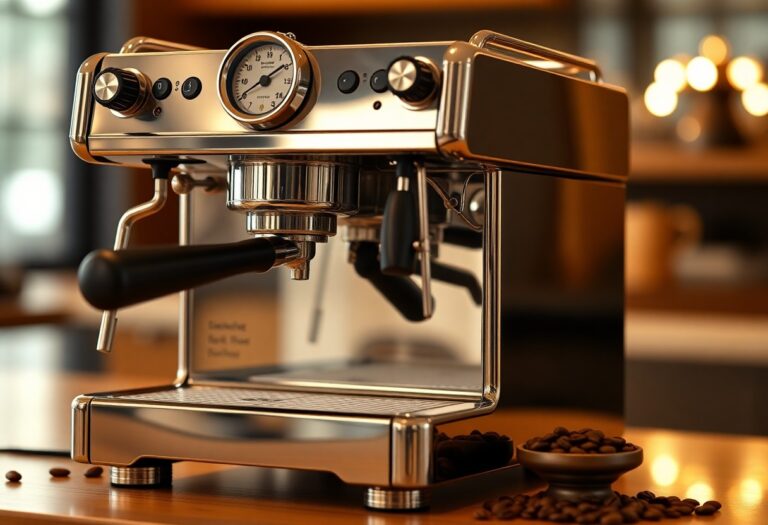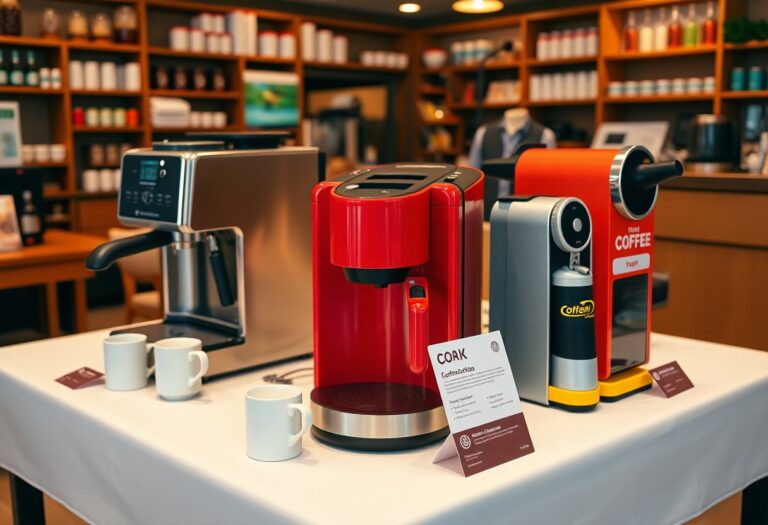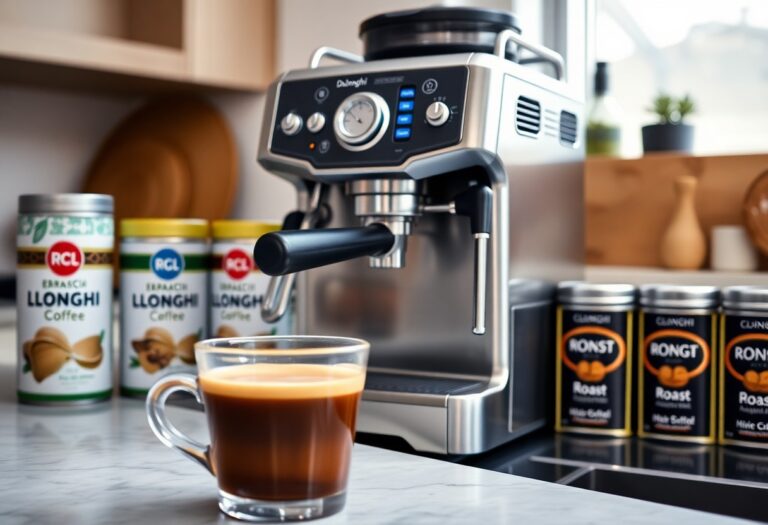What is the Name of a Coffee Machine – Terminology Guide
You might be surprised by the variety of terms associated with coffee machines. Understanding the different names and functionalities can enhance your brewing experience and help you choose the right machine for your lifestyle. This guide will walk you through important coffee machine terminology, from espresso makers to drip coffee brewers, ensuring you have a solid grasp of what each type offers. With this knowledge, you can make informed decisions that lead to your perfect cup of coffee.

Key Takeaways:
- Coffee machines come in various types and designs, including drip coffee makers, espresso machines, and single-serve brewers, each serving different brewing methods.
- Terminology like “thermal carafe,” “brew basket,” and “water reservoir” are imperative for understanding the components and functionality of different coffee machines.
- The terms “automatic” and “manual” denote the level of user control in the brewing process; automatic machines offer convenience, while manual machines allow for more hands-on brewing techniques.
- Understanding brewing capacity is important, as coffee machines vary from single-cup brewers to those that can serve multiple cups at once.
- Familiarity with maintenance terms such as “descaling” and “cleaning cycle” can help ensure the longevity and optimal performance of a coffee machine.
Unpacking Coffee Machine Nomenclature
Understanding the nomenclature of coffee machines involves delving into various terminologies that define their distinct functions and designs. Recognizing names such as “drip coffee maker,” “espresso machine,” or “French press” helps you navigate the expansive coffee universe more effectively. Each term encapsulates not only the machine type but also the brewing method, ingredients, and even the cultural identity associated with coffee preparation. Expertise in this vocabulary empowers you to make informed choices tailored to your preferences and brewing style.
The Language and Labels of Coffee Machines
Labels on coffee machines often specify their features—think of words like “programmable,” “automatic,” or “grinder.” These descriptors inform you about the machine’s technological capabilities, which can drastically impact your coffee-making experience. For example, a “single-serve” label hints at a machine designed for convenience and speed, ideal for busy mornings. Understanding these labels equips you to assess machines that align with your coffee habits.
The Evolution of Coffee Terminology
The language surrounding coffee has adapted dramatically over the years, influenced by technological advancements and cultural shifts. Traditionally, terms like “percolator” and “siphon” described methods that have almost vanished from everyday use. The rise of specialty coffee shops and consumer interest in artisanal brewing has birthed newer terminology, like “pour-over” and “cold brew,” reflecting contemporary preferences. This evolution not only reflects changing tastes but also signifies a broader appreciation for coffee craftsmanship and quality.
In the 20th century, coffee terminology primarily revolved around brewing methods and machine types, with a heavy focus on utility and speed. Now, you can find a vibrant lexicon that spans the globe, showcasing unique brewing traditions from different cultures. For instance, the introduction of espresso machines has popularized terms like “ristretto” and “macchiato,” bridging the gap between casual coffee drinkers and aficionados. This shift illustrates the growing sophistication of the coffee community, where understanding the language of coffee can significantly enrich your experiences and elevate your appreciation for this beloved beverage.
Decoding Components: Parts That Brew
Understanding the Anatomy of a Coffee Machine
Every coffee machine comprises distinct components that work in unison to produce your daily brew. From the water reservoir that stores the liquid to the brew head that distributes water over the coffee grounds, each part is necessary. For deeper insights into these components, you can refer to the Dictionary of Coffee and Espresso Equipment. Understanding their functions allows you to appreciate how small modifications can affect your beverage’s quality.
The Roles of Individual Components in Brewing
Each part of your coffee machine plays a specific role in the brewing process. The boiler heats the water, while the pump delivers the pressurized liquid through the coffee grounds. Furthermore, the filter basket holds the coffee, allowing brewed liquid to flow into your carafe, creating a balance that directly influences flavor and aroma.
The interplay of these components shapes your coffee experience, making it vital to know how they function. For instance, a well-functioning pump maintains optimal pressure, ensuring water flows evenly through the grounds, which enhances extraction. If the boiler fails to heat adequately, the brew may become under-extracted, resulting in a sour taste. Recognizing these roles enables you to troubleshoot better and optimize your brewing techniques for that perfect cup.
Machinery Styles: Beyond the Basics
Exploring the various styles of coffee machinery allows you to find the perfect fit for your brewing preferences. From the classic to modern innovations, you will discover machines designed for different brewing methods, each offering unique features and flavors. Knowledge of these styles empowers you to select a coffee maker that aligns with your taste and lifestyle, whether you enjoy the simplicity of drip coffee or the bold richness of espresso.
Differentiating Between Espresso, Drip, and French Press
Choosing between espresso, drip, and French press machines involves understanding how each method extracts flavors. Espresso machines force hot water through finely-ground coffee under high pressure, creating a concentrated shot with a rich crema. Drip coffee makers use gravity to extract flavor from coarser grounds, producing a smoother cup. The French press relies on steeping coarsely-ground coffee in hot water before pressing down a plunger, resulting in a full-bodied brew. Each method caters to different taste preferences and brewing rituals.
The Rise of Specialty Coffee Machines and Their Unique Terminologies
Specialty coffee machines have emerged in response to the growing demand for high-quality brews and craft coffee experiences. Terms like “pour-over,” “cold brew,” and “siphon” highlight the unique brewing techniques that elevate your coffee experience. These machines often incorporate innovative features such as programmable settings, precise temperature controls, and integrated grinders, catering to the discerning coffee enthusiast. Understanding these terms enables you to navigate the world of specialty coffee more effectively and appreciate the craftsmanship behind each cup.
The rise of specialty coffee machines has transformed home brewing, making it accessible and enjoyable for all. For example, pour-over systems like the Hario V60 and Chemex emphasize manual control over brewing variables, appealing to those who relish the art of coffee-making. In contrast, cold brew systems simplify the process, allowing you to steep your grounds for hours while retaining smooth flavors. Familiarity with these terminologies not only enhances your brewing journey but also connects you with a community of enthusiasts who appreciate the nuances of great coffee.
The Technical Jargon: A Deeper Dive
Delving into coffee terminology reveals layers of complexity that can significantly impact your brewing experience. Terminology can influence your understanding of the coffee-making process and your overall enjoyment of the beverage. Knowing technical terms will make conversations with baristas and other coffee enthusiasts richer and more impactful, allowing you to make better-informed choices in selecting coffee machines and beans.
Exploring the Metrics: Bar Pressure, Temperature, and Grind Size
| Bar Pressure | Ideal extraction occurs around 9 bars, significantly affecting flavor extraction. |
| Temperature | Optimal brewing temperatures range from 195°F to 205°F, impacting taste and aroma. |
| Grind Size | Finer grinds lead to quicker extraction while coarser grinds elongate the process. |
The Importance of Water Quality and Its Impact on Terminology
Your coffee’s flavor is significantly shaped by the quality of water used in brewing. Regions with hard water can introduce unwanted mineral flavors, while soft water may lack the important minerals needed for extracting complex flavors from your beans. Ideal water contains balanced minerals that enhance extraction, allowing your coffee’s inherent flavors to flourish. Understanding how water quality affects extraction and taste can deepen your appreciation for each cup and provide valuable insights into selecting the right machine for your preferences. By taking water quality into account, you position yourself to get the most out of your coffee experience.

Coffee Machine Comparisons: Terminology in Action
Understanding the terminology used in coffee machine descriptions not only enhances your purchasing decisions but also hones your coffee knowledge. By comparing features across brands, you can better assess which machine meets your specific needs and preferences. Below is a table clarifying common terms found in coffee machine descriptions.
| Term | Description |
|---|---|
| Espresso Pressure | Refers to the amount of pressure used to extract flavor from coffee grounds, typically measured in bars. |
| Blooming | A pre-wet phase in brewing that releases gas trapped in coffee, enhancing flavor. |
| Brew Time | The duration it takes to brew coffee, which can impact taste and strength. |
| Cup Warmer | A heated surface on the machine to warm your cups before pouring coffee. |
Breaking Down Features: What to Look For in Descriptions
In product descriptions, focus on features that contribute directly to the brewing process and user experience. Look for information about brewing methods, such as drip or espresso, and consider attributes like programmable settings for convenience. A good description should also highlight materials, ensuring durability, and capacity, revealing how many cups you can brew at once.
Analyzing Brand-Specific Terminology and What It Means
Each coffee machine brand often develops its own unique language for features, posing a challenge when comparing different models. For instance, a brand might refer to their espresso pump as “Hyperbrew Technology,” implying a faster brewing process, even if the underlying mechanism is similar to another brand’s model. Understanding these unique terms helps you discern actual benefits versus marketing jargon.
Dissecting brand-specific terminology reveals much about performance and technology. For example, brands like Breville tout “ThermoJet heating” to imply rapid heat-up times, which is crucial for maintaining consistent brewing temperatures. Similarly, others may use terms like “Intelligent Brewing” to describe smart technology integration, which might appeal to those who enjoy automated coffee-making. By knowing what these terms imply, you can make a more informed decision based on your preference for practical features rather than buzzwords.
Summing up
From above, you’ve gained a comprehensive understanding of coffee machine terminology, enhancing your ability to choose the right equipment for your brewing needs. Whether you’re exploring espresso machines, drip brewers, or single-serve options, knowing the specific terms will empower you in your coffee-making journey. With this guide, you can confidently navigate the world of coffee machines and make informed decisions that elevate your coffee experience.
FAQ
Q: What is a coffee machine?
A: A coffee machine is an appliance designed to brew coffee by various methods, including drip brewing, espresso making, and special brewing techniques. These machines come in various forms, such as single-serve pod machines, traditional drip coffee makers, and espresso machines, catering to different brewing preferences and styles.
Q: What does the term ‘espresso machine’ mean?
A: An espresso machine is a type of coffee machine specifically designed to brew espresso coffee. This process involves forcing hot water through finely-ground coffee under high pressure. Espresso machines can vary from manual and semi-automatic to fully automatic, providing a wide range of control over the brewing process.
Q: What is a drip coffee maker?
A: A drip coffee maker, often referred to as a filter coffee machine, is one of the most common types of coffee machines. It works by heating water and allowing it to drip through ground coffee contained in a paper or metal filter. The brewed coffee then collects in a carafe below. These machines are user-friendly and suitable for brewing larger quantities of coffee.
Q: What is the difference between a single-serve coffee maker and a traditional coffee maker?
A: A single-serve coffee maker brews one cup of coffee at a time, usually using pods or capsules, making it convenient and quick for individual servings. In contrast, a traditional coffee maker typically brews multiple cups simultaneously, often utilizing ground coffee and a filter. The choice between the two depends on personal preference and consumption habits.
Q: What does the term ‘grinder’ refer to in coffee terminology?
A: A grinder is a device used to crush coffee beans into smaller particles for brewing. The grind size can significantly influence the flavor and strength of the coffee, with options ranging from coarse to fine. Some coffee machines include built-in grinders, while standalone grinders offer more flexibility for controlling the grind size according to the brewing method being used.







